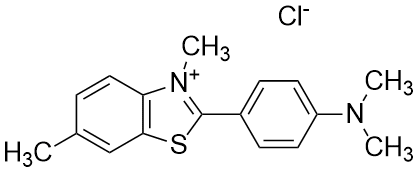Thioflavin T is widely utilized in research focused on:
- Protein Aggregation Studies: It is commonly used as a fluorescent dye to detect amyloid fibrils in various neurodegenerative diseases, helping researchers understand conditions like Alzheimer's.
- Cellular Imaging: This compound is employed in live-cell imaging to visualize cellular structures and processes, providing insights into cell behavior and function.
- Drug Discovery: Thioflavin T is valuable in screening potential drug candidates that target protein misfolding, aiding pharmaceutical companies in developing effective treatments.
- Environmental Monitoring: It can be used to assess the presence of certain pollutants in water samples, contributing to environmental safety and compliance.
- Biomarker Development: The compound plays a role in the identification of biomarkers for various diseases, enhancing diagnostic capabilities in clinical settings.
Información general
Propiedades
Seguridad y normativas
Aplicaciones
Thioflavin T is widely utilized in research focused on:
- Protein Aggregation Studies: It is commonly used as a fluorescent dye to detect amyloid fibrils in various neurodegenerative diseases, helping researchers understand conditions like Alzheimer's.
- Cellular Imaging: This compound is employed in live-cell imaging to visualize cellular structures and processes, providing insights into cell behavior and function.
- Drug Discovery: Thioflavin T is valuable in screening potential drug candidates that target protein misfolding, aiding pharmaceutical companies in developing effective treatments.
- Environmental Monitoring: It can be used to assess the presence of certain pollutants in water samples, contributing to environmental safety and compliance.
- Biomarker Development: The compound plays a role in the identification of biomarkers for various diseases, enhancing diagnostic capabilities in clinical settings.
Documentos
Hojas de datos de seguridad (HDS)
La SDS proporciona información de seguridad completa sobre la manipulación, el almacenamiento y la eliminación del producto.
Especificación del producto (PS)
La PS proporciona un desglose completo de las propiedades del producto, incluida la composición química, el estado físico, la pureza y los requisitos de almacenamiento. También detalla los rangos de calidad aceptables y las aplicaciones previstas del producto.
Certificados de análisis (COA)
Busque certificados de análisis (COA) ingresando el número de lote del producto. Los números de lote y de partida se pueden encontrar en la etiqueta de un producto después de las palabras "Lote" o "Lote".
Número de catálogo
Número de lote/lote
Certificados de origen (COO)
Este certificado de origen confirma el país en el que se fabricó el producto y también detalla los materiales y componentes utilizados en él y si se deriva de fuentes naturales, sintéticas u otras fuentes específicas. Este certificado puede ser necesario para cumplir con las normativas aduaneras, comerciales y regulatorias.
Número de catálogo
Número de lote/lote
Hojas de datos de seguridad (HDS)
La SDS proporciona información de seguridad completa sobre la manipulación, el almacenamiento y la eliminación del producto.
DownloadEspecificación del producto (PS)
La PS proporciona un desglose completo de las propiedades del producto, incluida la composición química, el estado físico, la pureza y los requisitos de almacenamiento. También detalla los rangos de calidad aceptables y las aplicaciones previstas del producto.
DownloadCertificados de análisis (COA)
Busque certificados de análisis (COA) ingresando el número de lote del producto. Los números de lote y de partida se pueden encontrar en la etiqueta de un producto después de las palabras "Lote" o "Lote".
Número de catálogo
Número de lote/lote
Certificados de origen (COO)
Este certificado de origen confirma el país en el que se fabricó el producto y también detalla los materiales y componentes utilizados en él y si se deriva de fuentes naturales, sintéticas u otras fuentes específicas. Este certificado puede ser necesario para cumplir con las normativas aduaneras, comerciales y regulatorias.

